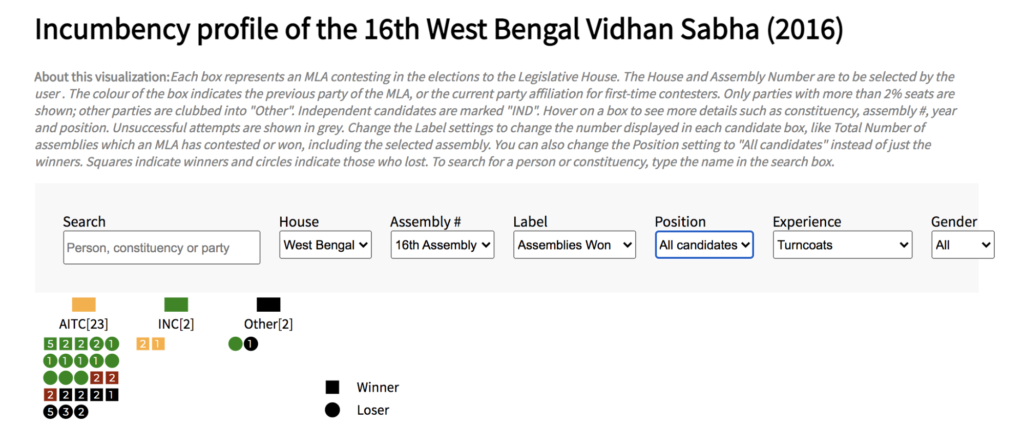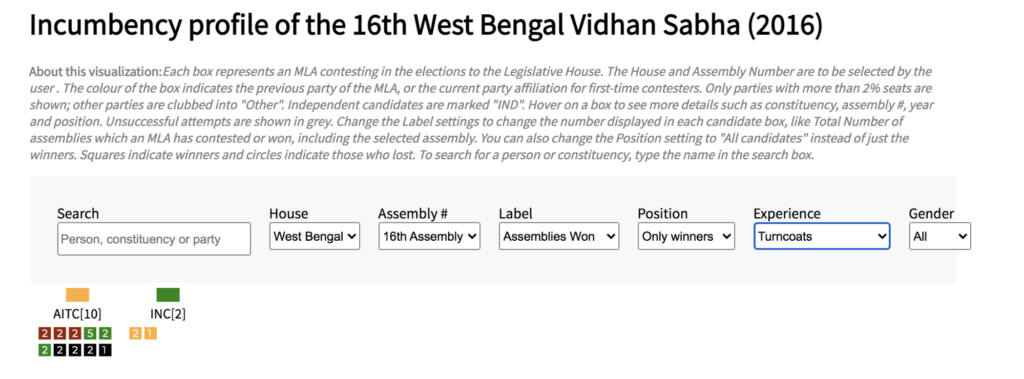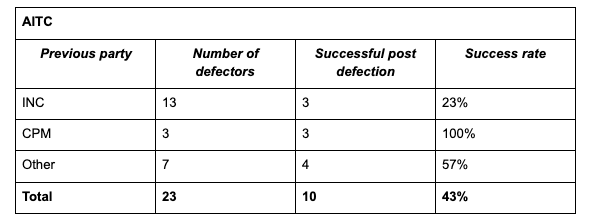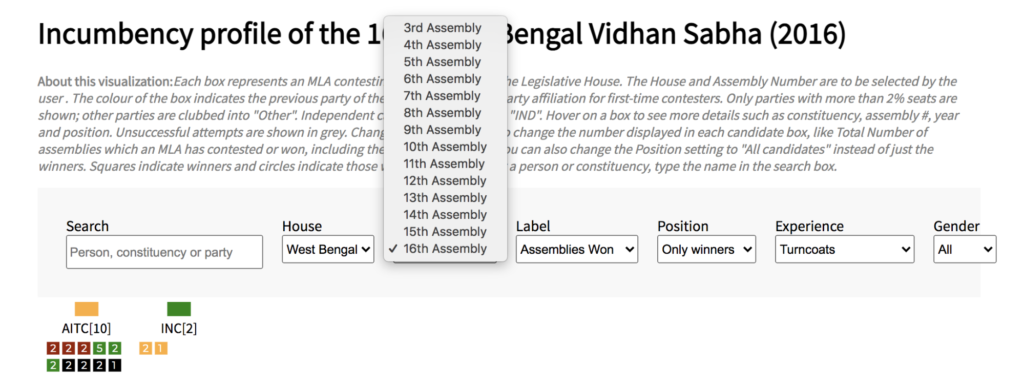Aishwarya Sunaad, Ananay Agarwal and Priyamvada Trivedi
12 March 2021 | 2 min read
Political defections, the switching of parties by legislators or Members of Parliament, have become increasingly characteristic of the world’s largest democracy. In light of the impending West Bengal Assembly elections, we focus on the number of political defections over the years in the state through TCPD’s tool for Incumbency Visualisation to gain a few insights.
In January this year, Rajib Banerjee, Baishali Dalmiya, Prabir Ghoshal, Rathin Chakraborti and Rudranil Ghosh left the All India Trinamool Congress (AITC) to join the Bharatiya Janata Party (BJP) and set the stage for elections in West Bengal. But will defections, which have been observed to be common in previous Assembly elections, most notably in Madhya Pradesh and Karnataka, script a new narrative for the state’s politics? One approach to this is to look at how defectors have historically fared after bidding good-bye to their earlier parties. With our carefully collated and documented data on incumbency, the visualization tool helps in understanding the trends in defections and how things have panned out so far, even if it cannot predict the future! Let us look at defections in West Bengal over the years.
Using the tool
Figures 1, 2 and 3 show the selections that need to be made in order to look only at defectors or “turncoats”. Figure 1 shows all those who defected, and Figure 2 shows the ones who defected and also won in the 2016 West Bengal assembly elections.
Figure 1: All political defectors in the 2016 West Bengal Assembly elections

Figure 1 tells us that there were 23 defections into AITC, 2 defections into INC and 2 into Other political parties. The tool clubs political parties who won less than 2% of the seats and independent candidates into ‘Other’.
Figure 2: Successful political defectors in the 2016 West Bengal assembly elections

Figure 2 tells us that out of the 23 defectors into AITC, 10 were successful which puts the success rate at about 43%; of the 2 defectors into INC, both were successful which puts the success rate at 100%.
Looking at the colours of the candidates in the tool, we can also see the previous political party the defectors were affiliated to. To reiterate, Figure 1 shows that there are 23 defections into AITC. In order to study our data better, we summarize the information from Figures 1 and 2 into Table 1 and chart them in Figure 3 below.
We see that out of the 23 defectors into AITC – 13 came from INC out of which 3 were successful (23% won), 3 came from CPM and all won (100% success rate) and out of the 7 that came from Other parties, 4 were successful (57% success rate). Similarly, INC had 2 defectors, both of whom came from AITC and both of whom were successful (100% success rate).
Table 1: Defections into AITC for 2016 West Bengal Assembly elections

Figure 3: Number of defectors into AITC for 2016

Defections over the years
So far we have looked only at the defectors in the last round of elections in West Bengal. What do the numbers and rates look like if we go further back in time? The tool allows us to do exactly this by selecting previous Assemblies in the “Assembly #” menu, as visible in Figure 4. The corresponding electoral year is displayed at the top of the page in brackets.
Figure 4: Exploring historical data

Figure 5 shows us the number of defectors into the AITC in 2011 (9 defected, 6 won, 3 lost), 2006 (12 defected, 1 won, 11 lost) and 2001 (92 defected, 26 won, 66 lost) respectively. However, do we want to label those who leave to form a new political party as defectors or turncoats? Out of 92 who joined AITC, 81 came from the INC. In 1997-98, there was a split in the INC. One faction was the AITC led by Mamta Banerjee which contested elections for the first time in 2001. The visualisation tool allows users to see such changes but remember, making sense of these changes requires digging behind the numbers and learning about what happened!
Figure 5: AITC: Defectors in 2011, 2006 and 2001 respectively historical data

Defections and success
What we have learned so far is that political defections have been occurring before every election and affecting almost every major political party in West Bengal since 2001. While the reasons for defections might be dissatisfaction with the inner-workings of parties or political opportunism, the performance of defectors or turncoats varies across the years.
To conclude, we can say that turncoats are not always successful in West Bengal, and following the emergence of the AITC in the state in 2001, the number of turncoats has been significantly lower since then.
We encourage you to explore the data and use the incumbency tool. It is the product of a lot of time, hard work and love put in by TCPD staff members and our fabulous interns. If you spot errors and/or have any feedback, please get in touch with us at tcpd-contact@ashoka.edu.in
References
Verniers, Gilles. “Why defections continue to cast a shadow on politics | Opinion” Hindustan Times http://www.hindustantimes.com/analysis/why-defections-continue-to-cast-a-shadow-on-politics/story-4Fs0vOMzmpBX9YVYiadMsL.html.
Datta, Romita. “Is the BJP Cleaning the TMC’s Dirty Laundry? .” India Today, www.indiatoday.in/india-today-insight/story/is-the-bjp-cleaning-the-tmc-s-dirty-laundry-1766030-2021-02-04.
TCPD Individual Incumbency Dataset, 1962-current. Trivedi Centre for Political Data, Ashoka University.
Ananay Agarwal, Prashasti Agarwal, Payoja Ahluwalia, Saloni Bhogale, Jenish Raj Bajracharya, Sudheendra Hangal, Samridhi Hooda, Mohit Kumar, Visvesha Murthi, Basim U Nissa, Vaibhav Parik, Ayaan Sagar, Niharika Tiwari and Gilles Verniers. 2021. “TCPD Individual Incumbency Dataset, 1962-current Codebook 1.0″, Trivedi Centre for Political Data, Ashoka University.

